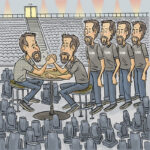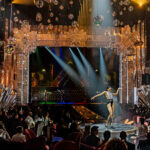John Lyons: The two-edged sword that is nightclub design is that there are no real rules. By their very nature, nightclubs and their lighting need to be redone on a weekly basis. A lighting operator in a nightclub needs a basic foundation lighting rig to work with, but they also require a sizeable toolbox of tricks and effects that they can rotate in and out of a show. Thoughtful design is one that does not hem the light jock in and permits them the freedom to improvise on the fly. [When] my partner, Richard Worboys, and I approach a design, it is from the POV of the operator.
Michael Meacham: The freedom to be as creative as you want. We do not need to be as concerned with practical lighting. Instead of calculating foot candles for general lighting, we can truly think outside of the box. Programming plays a major part in our designs. When designing a moving light rig or a feature installation, we think as programmers, “How cool can I make this?” If we can keep it interesting to us by pushing our creativity, we know that we can make interesting to others.
Stephen Lieberman: Each project is unique — no two clubs are the same. When I design a system for a nightclub, I am always considering the architecture first. You never want your system to look like an after-thought. You have to have a balance in your designs. That balance needs to translate internally within the design and also externally throughout the rest of the project and the other disciplines that are involved.
—From “Designing for Nightclubs,” a roundtable moderated by Justin Lang, PLSN, June 2011


